Alice Springs (Page 1/3): Anzac Hill and The Town
With a population of over 25,000, Alice Springs is the third largest town in Australia's Northern Territory. The Alice, as it's often known, is situated roughly in the geographic centre of Australia and lies nearly halfway between Adelaide and Darwin. To the Arrernte Aboriginal people, whom have lived around this area for thousands of years, the site is known as Mparntwe. The town lies on the floodplains of the usually dry Todd (Lhere Mparntwe) and Charles (Anthelke Ulpeye) Rivers, in the heart of the MacDonnell Ranges, which extend 400km east and west of it.
There is plenty to do and see in and around the town, indeed a comment by travellers often heard is that they wished they had more time to spend here. Thus, coverage of The Alice on this website is far from comprehensive, although enough to warrant three separate web pages. This page starts off with a look at Anzac Hill and the town itself, whilst page two looks at two main sites: The School of the Air and The Royal Flying Doctor Service. Page three takes a relatively in-depth look at The Alice Springs Telegraph Station and finishes with a look at the site of the original Alice 'Spring', which the town became to be named after.
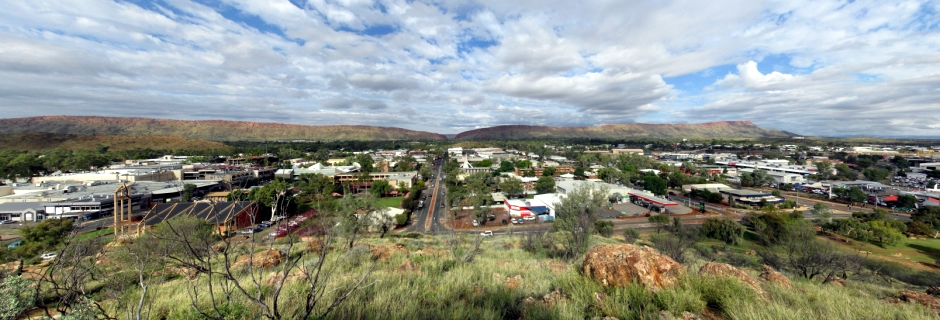
Above: Panoramic stitch of Alice Springs as seen from Anzac Hill (looking south-southwest). In the distance in the centre can be seen between the hills the Heavitree Gap, through which the Central Australian Railway, the Stuart Highway and the (usually dry) Todd River run south from the town.
Anzac Hill
Overlooking the town stands Anzac Hill, atop which lies an important war memorial. The hill is one of, if not, the town's most visited sites and from the memorial, it is possible to get 360° panoramic views of the town and surrounding ranges.
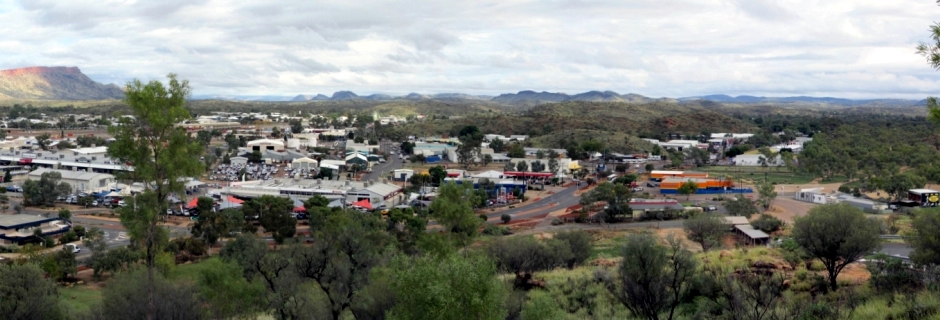
Above: Panoramic stitch of view from Anzac Hill, looking west-northwest
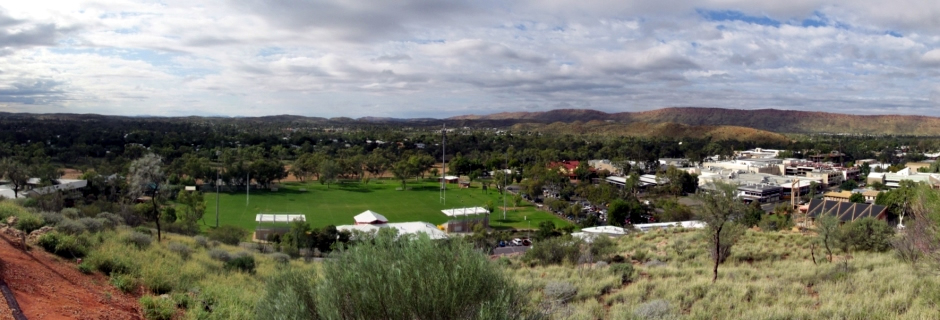
Above: Panoramic stitch of view from Anzac Hill, looking southeast over the Anzac Oval which is used for rugby league and union, concerts and community events. Just visible immediately beyond the pitch through the trees is the dry bed of the Todd River (Lhere Mparntwe).
The hill is both a sacred site for the Aboriginal people and of historic significance to the Europeans. The Arrernte Aboriginal people know this hill as Untyeye-artwilye, which is derived from two words meaning 'corkwood' and 'story'. It is the site of the Corkwood Dreaming, part of the story behind the creation of the landscape. The story tells of a woman who lived alone on the hill and avoided men. The hill is also known as Atnelkentyarliweke after its association with a rock in the Todd River bed which is linked to the Caterpillar Dreaming; the ancestral beings associated with this site are three species of caterpillars, the wild dog puppies and the journey of two sisters whose dreaming trail extends 100's of kilometres from South Australia.
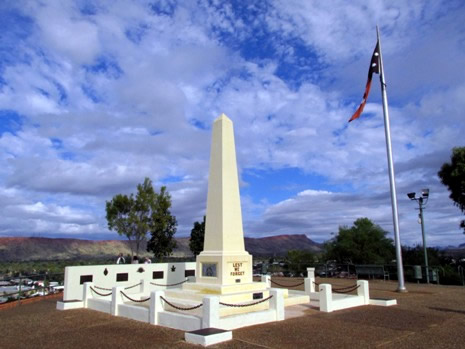 |
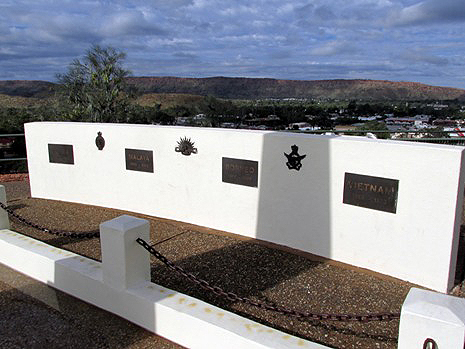 |
|
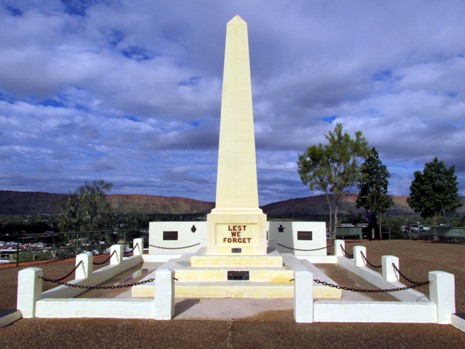 |
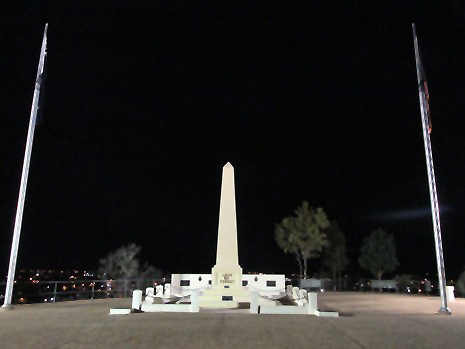 |
During the first 60 years of European settlement, Anzac Hill became known under various names ('The Hill', then 'Stott Hill' and the originally named 'View Hill'). It was named Anzac Hill in 1934 in memory of the soldiers of the Australian and New Zealand Army Corps (ANZAC) who were killed in World War I. Every year on ANZAC day, dawn services are held here at the memorial, which itself was designed by the Rev Harry Griffiths in 1933 and unveiled on ANZAC Day in 1934. During World War II, Alice Springs saw a large military presence with a large camp established below the hill for soldiers of the Australian Army's Darwin Overland Maintenance Force, who operated vehicular convoys carrying supplies and personnel northwards throughout the war years. Although originally dedicated to all members of the armed services who died during World War I, it has now become a memorial to all Australians who have served in the defence of their country in all wars the nation has participated in.
There are two popular routes to the war memorial at the top of the hill; the Lions walk runs up the side of the hill from Wills Terrace, whilst on an opposing side, access via vehicle is via the steep Anzac Hill Road, where a small car park is sited not too far below the memorial.
Alice Springs: A Brief Introduction and the Town
Set against the backdrop of the colourful MacDonnell Ranges, Alice Springs is a modern Outback town with all the conveniences of a capital city. Today, it is a far cry from its humble beginnings as a remote Telegraph Station in 1871. The town is relaxed and with the many modern facilities not available for many hundreds of kilometres around, a welcome sight for the weary traveller and an ideal base from which to explore Central Australia. Visitors approaching along the Stuart Highway from the north will see the welcome sign near the top of this page, whilst those from the south will find themselves driving through a gap in the ranges (Heavitree Gap), alongside the railway line to the town where large gum trees standing in the Todd River, which is dry most of the time. As we will see later on page 3, the town took it's name from the 'springs' by the Overland Telegraph Station, though was originally named 'Stuart'.
Above: Panoramic stitch of Todd Street (a non-pedestrianised section)
Alice Springs has a wide, varied and surprisingly many unique attractions for the visitor and the main beauty of them lies in giving an insight into the many facets of life in the Outback. The rich Aboriginal culture is to be seen all around, with art galleries which feature the different traditional and contemporary styles of art from the surrounding regions. Many restaurants and cafes serve a variety of food both indoors and outdoors and the shops offer a wide range of souvenirs as well as practically most things you would expect from a modern town. Alice Springs can be approached by air (Alice Springs airport), road (including coach/bus services) or by train via the Ghan (booking essential). The accommodation is wide ranging and includes a number of campgrounds, youth hostel or hotel options.
The thumbnail gallery above shows the main central area of Alice Springs and a selection of some of its points of interest follow this paragraph. In the main central area is to be found Todd Mall, the pedestrianised shopping heart of the town, where anybody souvenir-hunting may well find themselves in their element. For those interested, a self-guided Heritage Walk brochure is available from the National Trust Office in the Old Hartley St School. Some other points of interest in Alice Springs not featured on these web pages include (amongst others) Alice Springs Cultural Precinct, Alice Springs Desert Park, Pioneer Cemetery, Pyndan Camel Tracks, Lasseter's Casino & Alice Springs Convention Centre, the National Pioneer Women's Hall of Fame, Olive Pink Botanical Garden and the Transport Heritage Centre. Alice Springs has earned a bit of a reputation for quirky events, including the Henley on Todd Regatta (a rival to the one at Henley-on-Thames in the UK) , which involves a rather eccentric "boat" race on foot on the dry riverbed. Other annual events are the Heritage Festival, Finke Desert Race, Lions Camel Cup and Alice Springs Rodeo. As a point of note, in the camel races, the camels do not necessarily head in the direction of the finish line. Numerous operators run tours out of the town including hot-air balloon flights and camel safaris. Using the town as a base, there are many stunning scenic locations worth visiting in different directions, some on sealed roads and others on unsealed roads where a 4WD is required (or take a tour).
The John Flynn Memorial Church is shown above. This was built to honour Reverend John Flynn, who's hard work for 40 years helped improve the lives of people in the Outback. His practical Christianity meant he was regarded highly not just to regular church-goers (building hospitals, rather than churches). His leadership of the Australian Inland Mission saw the building of hospitals in remote places and the founding of The Royal Flying Doctor Service (more on page 2). The church's foundation stone was laid in 1954 by the Prime Minister, Robert Menzies, and it officially opened in May, 1956.
Adelaide House (Above) was the first hospital in Central Australia. It was built by Reverend John Flynn's Australian Inland Mission and opened in 1926.The Mission built some 14 such hospitals for the people of inland Australia from 1912-1939 and each was staffed by two nursing sisters. The hospital in Alice Springs was designed specifically for the Outback climate with a special cooling system, drawing fresh dust-free air in to the rooms from the cellar in which hung wet bags, the air then escaping through openings under the roof. This special design helped the staff and patients in the hospital with the long hot summertime weather. The building was also the first in the town to have electric lighting and a sewerage system. Adelaide House is one of the most important 'heritage' buildings in Australia due to the innovative design of it's time.
The photo above shows a memorial to John McDouall Stuart (1815-1866). This is located outside the Royal Flying Doctor Service Base (see page 2) and Alice Spring's Reptile Centre (which contains an impressive collection of snakes, lizards and other Reptilia). The statue was gifted in 2010 to the Alice Springs Town Council by the McDouall Stuart Freemasons. John McDouall Stuart and his team were the first Europeans to pass though this region, discovering Australia's centre in 1860. Mainly as a result of his expeditions and mapping, control of the Northern Territory was transferred to South Australia. The Overland Telegraph Line (see page 3) was mainly constructed along his route, as was the original Central Australia Railway (Ghan) from Adelaide to Alice Springs. South Australia established a settlement near Darwin on the north coast and vast areas in the Territory opened up for pastoral use and mineral exploitations.
The photo above is of The Residency. Between 1926 and 1931, under Federal legislation, Central Australia was a separately administered region. The Residency in Alice Springs was home to the first and only Government Resident of Central Australia, John Cawood. Although this period of independence for the region was only brief, The Residency building continued as the hub for the social activity of the town's elite. Royal visitors here have included Queen Elizabeth II and the Duke of Edinburgh, in 1963. As well as its social importance, the building is also considered one of note architecturally.
The final photo on this page is taken from
outside the Railway Station. Although the original station opened in
Railway Terrace in 1929, when the Central Australian Railway started
running, the present station opened in 1980, when a new line began
operating to Tarcoola. The station was the terminus of the railway line
from South Australia until 2004 when the line northwards to Darwin was
finally completed and opened. After a 70 year wait, the famous Ghan
passenger train began operating all the way from Adelaide to Darwin. The
Ghan is operated by Great Southern Rail and takes 54 hours to
travel the 2,979km line, stopping here in Alice Springs for four hours.
The Ghan operates weekly in each direction, (twice between May
and August).
[References and further reading on Page 3]
Next Page (School of the Air and The Royal Flying Doctor Service)
Jump to Page 3 (Telegraph Station and The Original 'Spring')